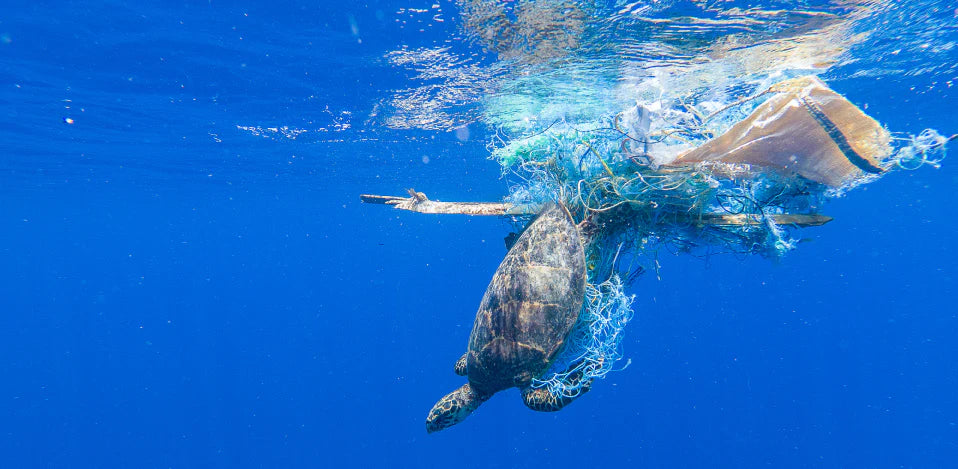5 MIN READ
5-28-2024
Sperm Whale Washed
Up With At Least 7 Types
Of Fishing Nets
In Stomach
Mikaela Walsh, 4ocean Research Analyst
A giant 60-ton whale dead; why? Most likely because of the tremendous amount of ingested plastic debris.
A 56-foot-long sperm whale washed along the coastline of Hawaii in early 2023. At first glance, this sperm whale had no apparent cause of death, but when researchers opened the whale to perform the necropsy, the story changed. This massive sperm whale was bursting with plastic debris in its stomach. The whale's stomach was so significant in volume that they could not examine the entirety of the organism's contaminants, but what they uncovered shocked the researchers.
The researchers found their typical food source inside this whale, including squid beaks and fish skeletons. In addition to this, they recovered several artificial contaminants, including:
- At least six hagfish traps
- At least seven types of fishing nets
- At least two types of plastic bags
- A plastic light protector
- Fishing line
- A float
Although the amount of artificial debris inside the whale's stomach raised significant concerns, the story worsens. It was reported that the sphincter connecting the whale's stomach to the gastrointestinal tract was smaller; furthermore, nothing was found in the intestines. Ultimately, the plastic and fishing debris caused an intestinal blockage in which the whale was unable to pass the broken-down food from the stomach to the intestines to absorb the nutrients into the bloodstream. This was further validated because the fish skeletons and squid beaks, along with other organic matter, were still identified in the animal's stomach, rather than passing through the intestines and out of the digestive tract. This leads them to believe that the voluminous amount of plastic debris that this whale ingested is a contributing factor in its death. Tragically, this caused the whale to starve from absence of nutrients. Sperm whales are massive animals that must eat up to 3.5% of their body mass daily to receive enough nutrients to sustain themselves. Therefore, in this scenario, the sperm whale seemed full, and appeared unable to pass food through its intestinal tract to obtain nutrients.
To further explain the travesty in Hawaii, the researchers demonstrated that they can not conclude the actual number of occurrences. Whale and dolphin necropsies take a lot of power and time. This whale, in particular, took at least 15 hours to perform the necropsy, but a 56-foot whale is massive, and they were unable to examine the entirety of the stomach due to the enormous size of this organism. Consequently, whales, dolphins, and other large animals that wash up can not all have necropsies completed due to the time needed before decomposition. Thus, each individual necropsy performed represents up to 20 individuals who become beached, based on percentages. The University of Hawaii Health and Stranding Lab performed this research and explained that this is likely not the only instance of this occurring. This further gives reason to believe that even though it is reported in one instance, it is most likely happening in many more animals than this specific sperm whale.

Sperm whales are enormous organisms that are seen across the world in every ocean system. It is unconcluded if the sperm whale was feeding off the plastic for an extended period of time while it was building up in its stomach or if the plastic was engulfed in one swoop. Hawaii is located in the Pacific Ocean. Could the Great Pacific Garbage Patch have caused this? The Great Pacific Garbage Patch is a region in the Pacific Ocean estimated to have an area of twice the size of Texas. It is a known area of plastic pollution in our oceans due to all the currents circling, pushing a significant number of plastic debris into one location. This area is a dense plastic zone composed of fishing nets, plastic debris, and all forms of artificial matter. Tackling this patch is extremely hard due to its location and the circumference of the patch. The density of the patch is due to the ghost nets that have been collecting and catching all forms of debris, essentially tangling everything together. Further examinations of the impacts of the floating plastic debris should be evaluated to understand the effects of this region fully.
Commercial whaling practices were performed across whale populations from the 1800s until 1986 when the International Whaling Commission placed a moratorium on commercial whaling. This moratorium was placed because all whale populations had such low populations that they were highly vulnerable. Sperm whales were introduced to the Endangered Species Act in 1970 as an endangered animal. These efforts have helped assist sperm whale populations, which are increasing yet are still a vulnerable species in our oceans.
Plastic pollution is a heartbreaking tragedy in every single waterway. Similar occurrences of this have been documented and reported across all marine life populations. Plastic ingestion has deadly effects on aquatic life. Plastic is manufactured to last forever, even in an animal's stomach. The organism is unaware that they are consuming a death trap and thinks they are consuming organic matter. For example, a clear plastic bag drifting in the water resembles a jellyfish. This leads them to have intestinal blockages, inflammation, and the ultimate executioner: starvation.

Plastic pollution is not just an eyesore; but it is a killer. All marine life is crying for help, and we have the ability to give a voice to the voiceless. Advocating and educating people about the dangers of plastic pollution and its reality is essential to making a change. Reducing your single-use plastic consumption is imperative. Switching to reusable options can save these organisms. Recycling properly can be a game changer for our oceans. Every single plastic item you use, even if it's for 10 minutes, will stay on Earth for decades and centuries to come. Let’s create generational change and help marine life survive in a sea of plastic.

You May Also Like




